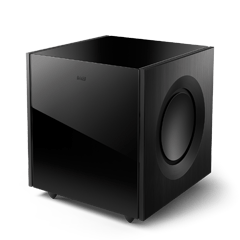If you're looking to elevate your listening experience further, our range of high-performance subwoofers seamlessly complement any audio system.
In this blog, we’ll discuss the know-how of successfully connecting your subwoofer to your existing home audio system so you can enjoy intricate sound-filled moments the way the artists intended.

Why Use a Subwoofer?
A subwoofer is designed to reproduce low-frequency sounds, which are often difficult for standard speakers to handle. By taking on this responsibility, subwoofers allow your other speakers to perform better, creating a more balanced and detailed soundstage.
To learn more about the role of subwoofers, check out our comprehensive guide to subwoofers.

How to Connect Your Subwoofer to Your Audio System
If you’re looking for a seamless connection between your subwoofer and your existing audio system, below are a few key factors to consider.
Placement Matters
Finding the optimal location for your subwoofer is crucial. Ideally, it should be placed near the front of the room, but avoid corners as they can cause bass to become boomy and less defined.
For further details on achieving the perfect audio setup, read our article on why subwoofers create more immersive audio experiences.
Wire Connections
Use a high-quality subwoofer wire to connect your subwoofer to the AV receiver. Plug one end into the ‘Sub Out’ or ‘LFE’ port on your receiver and the other into the subwoofer’s input. Plus, if you’re using KEF LS Wireless speakers, integrating a subwoofer is straightforward.
Refer to our guide on how to integrate a subwoofer with your LS Wireless speakers for step-by-step instructions.
Setting the Crossover Frequency
The crossover frequency determines which low frequencies are sent to your subwoofer and which go to your main speakers. A good starting point is around 80Hz, which can be adjusted based on your speaker size and room acoustics.
For more information on understanding subwoofers, take a look at our blog: What is a Subwoofer?
Adjusting the Volume
Your subwoofer should complement your speakers without overpowering them. It’s there to add depth and dimension but not to cause any unbalance to your audio output. We recommend starting with the subwoofer volume set at 50% and gradually adjusting from there. The goal is to achieve a balanced sound where the bass is present but not overwhelming.
Phase Adjustment
Phase control helps synchronise the subwoofer with the other speakers. If your bass sounds weak or hollow, try adjusting the phase switch between 0° and 180° to see if it improves the integration.
Fine-Tuning for Optimal Performance
Every room is different, so don’t be afraid to experiment with subwoofer placement and settings. Small changes can significantly impact the overall sound quality. If you use an AV receiver with room calibration features, run the calibration process after connecting your subwoofer to fine-tune the system for your specific environment.

How Do I Connect a Subwoofer?
Connecting a subwoofer involves using a subwoofer wire to link it to the AV receiver’s ‘Sub Out’ or ‘LFE’ port. Ensure the wire is securely connected, and adjust the settings on your subwoofer and receiver for optimal sound performance.
For more details, check out our complete guide to subwoofers.
What Is the Best Way to Set Up a Subwoofer?
Start by placing your subwoofer near the front of the room, avoiding corners to prevent sound distortion. Connect it to your AV receiver using a quality subwoofer wire, set the crossover frequency around 80Hz, and adjust the volume to balance the sound.
Learn more about getting the most out of your subwoofer setup in our recent guide: Why Subwoofers Create More Immersive Audio.
How Do I Connect a Subwoofer to an Amp?
To connect a subwoofer to an amp, use a subwoofer wire from the amp's ‘Sub Out’ or ‘LFE’ port to the subwoofer’s input. Some amplifiers may also have speaker-level inputs that you can use if your subwoofer supports them. Always read the manual provided with your chosen appliance for optimum results.
How Do I Connect a Subwoofer to a Soundbar?
If your soundbar has a dedicated subwoofer output or wireless subwoofer capabilities, connect the subwoofer wire or follow the manufacturer’s pairing instructions to link them. This setup can significantly enhance your home theatre experience by adding impactful bass.
What Is the Correct Subwoofer Connection for My System?
The correct connection depends on your specific equipment. Generally, use the ‘Sub Out’ or ‘LFE’ port on your AV receiver or amp and connect it to your subwoofer’s input. For wireless setups, ensure your subwoofer is compatible with your system. The appliance manual contains everything you need to know about your chosen device.
Find My Retailer
Find out more about our award-winning models and book a demo at your nearest KEF retailer.






